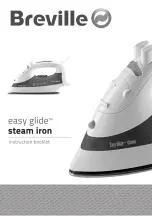
Tip # 27 - Iron shirts like a pro
Start with the collar, working from the outer
edges into the middle. Iron the shoulder
next, followed by the cuffs and sleeves.
Place the collar at the narrow end of the
board so that one front panel of the shirt
is extended flat. Iron the front panel from
shoulder to shirt tail. Rotate to iron the
back of the shirt. Rotate and complete the
remaining front panel.
Tip # 34 - Tips for T-shirts
Straighten seams on t-shirts before hanging
out to dry. To avoid damage to printed
graphics and logos turn the t-shirt inside out
and iron the reverse side of the print. Never
iron areas of your t-shirt where perspiration
marks are visible as the heat of the iron will
permanently fix the stain.
Tip # 54 - Hung out to dry
When washing is complete, remove shirts
from the machine immediately, shake them
out and hang them on coat hangers to air dry
– this will keep wrinkles to a minimum.
Tip # 18 - Selecting the right temperature
If you are unsure of the correct setting for a
particular garment, test a small area such as
a seam or inside hem before ironing a visible
area. Start with a low temperature and slowly
increase the heat to find the best setting.
Tip # 33 - Don’t be afraid to iron silk
Don’t be afraid to iron silk. Although delicate
in appearance, silk is the strongest and most
resilient of all natural fibres. To achieve the
best results, set to a low cotton setting and
use regular shots of steam. Always use a
pressing cloth to avoid shine marks.
Tip # 13 - Ironing the seam
Always press seams in the same direction
they were made. When a garment is
produced, the fibres will naturally settle
in the direction they were initially pressed,
so it’s best not to iron against the grain.
Tip # 26 - Sort types of fabric
Sort articles to be ironed according to the
type of fabric. This will reduce the need to
adjust the temperature constantly. Start with
articles requiring lower temperatures and
work your way through to items requiring
higher settings.
Tip # 2 - Summer frocks and frills
Steam is the key when ironing delicate
summer fabrics such as muslin, cotton and
linen. Don’t press down with the iron, simply
hover above the garment and steam it using
a vertical shot of steam. Ruffling, netting,
tulle or intricate hand detailing is also best
ironed using this method.
Tip # 5 - Pressing your winter woollies
Steam is crucial when pressing your winter
woollies. Woollen garments can be hung and
steamed using the vertical shot of steam
feature. After steaming, brush the garment
with your hand to plump up woollen fibres.
If ironing the garment flat it is best to use
a pressing cloth. Don’t be afraid to apply
pressure – steam and hold.
Tip # 42 - Table settings to impress
To avoid unwanted creases always iron
your table cloth after taking it out of the
cupboard. A dinner party is a special
occasion, so treat the table cloth as you
would your own outfit. For best results, lay
towels across your table and iron the table
cloth over the towels. This will save you time
and ensure a beautifully presented table
setting.
9
Ironing Tips and Tricks






























